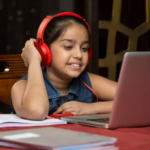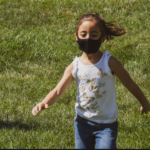COVID-19 QUARANTINE AND LOCKDOWN MYOPIA IN CHILDREN
In an effort to curb the spread of the SARS-CoV-2 virus, governments around the world have instigated lockdown measures, including school closures for children with remote learning. There has been much discussion of the difficulty this has brought on families and on school children themselves, but now researchers find there may be one more thing to worry about for children forced to stay at home to learn: increasing rates of myopia (nearsightedness).
SCHOOL CLOSURES AND AT-HOME LEARNING
Researchers have worried that at-home learning has forced children to spend even more time on digital devices, compounding an already existing problem of too much screen time for kids. Pediatric ophthalmologist Jordana M. Smith, MD notes that many schools were doing hour and a half long courses all day long with only a 5 minute break between courses. She said other schools had less direct screen time, combining screen lectures with at home work sheets. She said none of the at-home school programs she was aware of had scheduled outdoor time or physical activity time. A Canadian study showed that only 4.8% of children 5 – 11 years of age and only 0.6% of children age 12 – 17 had sufficient physical activity during COVID lockdown in Canada while 8 year olds in the study spent an average of 5.14 hours per day of screen time on digital devices during lockdown.
STUDY SHOWS MOST SIGNIFICANT EFFECT ON SIX TO EIGHT YEAR OLDS
A massive study by Wang et al of 123,535 children in China age 6 – 13 years old showed an increase in myopia during home confinement for COVID in 6 – 8 year olds, but not in children in the study. The authors of the study hypothesize that younger children are more susceptible to environmental factors than the older children in the group.
WHAT CAN BE DONE TO HELP?
Part of the problem is that children already spent too much time on digital devices even before COVID. A Common Sense Media report from October of 2019 showed that even before COVID, 8-12 year olds in the United States spent an average of five hours a day of screen time! Already screen time has been linked to an increased risk for developing or increasing nearsightedness in children. The addition burden of COVID lockdown at-home learning only massively compounds the problem. Parents should make efforts to minimize unnecessary screen time outside of required school screen time if possible. Other studies have shown that outdoor time can help prevent the development of myopia, so parents should make efforts to let their children outdoors during at-home learning as much as possible. The good news, of course, is that once children grow up, we have outstanding solutions for correcting their nearsightedness with LASIK or PRK laser eye surgery!


